
- Tabletop games
- Board games
- Tile-based games
- Turn-based games.html
- Abstract strategy games
- card games
- Connection games
- Mancala games
- Paper-and-pencil games
- Word games



Djambi (also described as "Machiavelli's chessboard") is a board game and a chess variant for four players, invented by Jean Anesto in 1975. The rulebook in French describes the game, the pieces and the rules in a humorous and theatrical way. Clearly stating that the game pieces intent to represent all wrongdoings in politics.
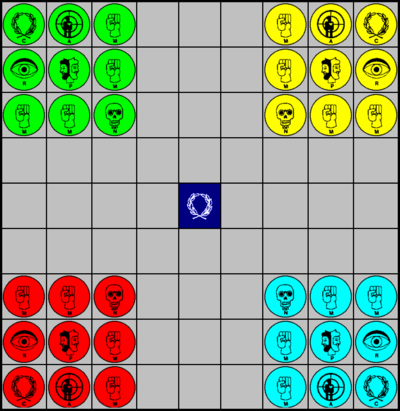 Board of Djambi, with the pieces in their start position. Each piece is identified by the first letter of its name as well as a symbol.
Board of Djambi, with the pieces in their start position. Each piece is identified by the first letter of its name as well as a symbol.The game is played on a 9x9 board whose central square (called "the maze") is marked with a different color or a sign. Each player has nine pieces:






The objective of the game is to get absolute power by being the last chief alive on board. Although informal alliances can be temporarily agreed upon, there is no team: each player plays against the other players.
The pieces are placed in each corner of the board as shown in the picture above. Order of play is red - blue - yellow - green.
Each player, at his/her turn, moves one of his/her pieces, and can possibly capture a piece in this way. The militants move of one or two squares in the eight directions; the other pieces can move through any number of squares in the eight directions. A piece cannot jump above another piece.
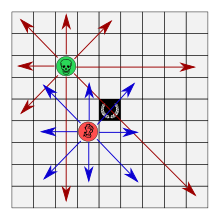 militant and regular piece move
militant and regular piece moveThe pieces are "killed" as soon as they are captured, but their "corpses" stay on the board (the pieces are turned upside down to show that they are "dead"). The militant kills by occupying the square of a piece (capture by replacement). He places the corpse on an unoccupied square of his choice, except on the central square (the "maze"). A militant cannot kill a chief in power (see the maze below).
 shows a move where chief piece kills and places corpses to protect himself against further moves
shows a move where chief piece kills and places corpses to protect himself against further moves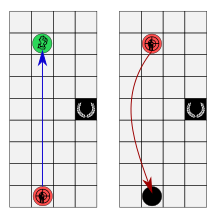 Forced placement of corpse when assassin kills.
Forced placement of corpse when assassin kills.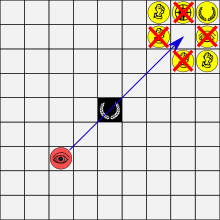 Reporter may kill one of orthogonal pieces at arrival. He may also move without killing.
Reporter may kill one of orthogonal pieces at arrival. He may also move without killing.The diplomat and the necromobile cannot kill the other pieces but can move them.
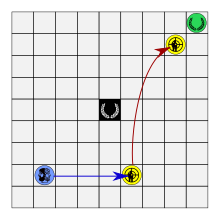 Advantageous positioning of living pieces of adversary.
Advantageous positioning of living pieces of adversary.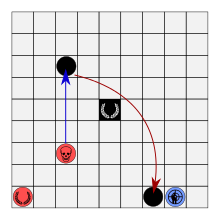 Protecting your pieces by moving corpses.
Protecting your pieces by moving corpses.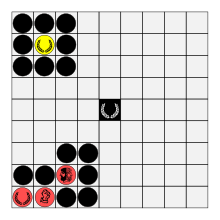 Chief dies if completely surrounded and has no necromobile. His pieces will become minions of chief in the maze or the first chief that enter the maze.
Chief dies if completely surrounded and has no necromobile. His pieces will become minions of chief in the maze or the first chief that enter the maze.When a player kills the chief of another player, he/she takes control of the remaining living pieces of this one. At his/her turn, he/she will have the choice between using one of his/her own pieces, or using one of the captured pieces. When a player has no necromobile and his chief is surrounded by corpses, he is eliminated (except if he is in power, in the maze). His/her pieces now belong to the chief in power. If there is no chief in power, then the pieces cannot be moved or killed, until the moment when a chief takes the power, and captures them in that way (he keeps control on these pieces even if he leaves the maze).
The central square of the board is called the maze. Each piece can go through this square, but the chief is the only piece that can stop on it. A chief who is in the maze is a chief "in power". He plays one time after each player. For instance, if there are four players, he plays three times in a turn (if there are two players, he plays twice consecutively). When he leaves the maze, he loses this power. A chief in power takes control of the pieces of the surrounded chiefs, and keeps them after losing the power. A chief in power cannot be killed by a militant. The surrounding has no effect on him as long as he stays on the maze. An assassin, a troublemaker or a necromobile can go in the maze to kill or move a living chief or a chief corpse, the piece must make an additional move immediately, in order to leave the maze. The original rule humoristically states that it's done to avoid things like an assassin empowered in the maze. It is done in this order :
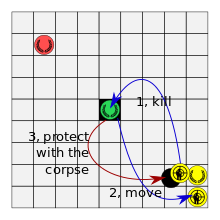 How to make the extra move when killing in the maze
How to make the extra move when killing in the mazeThis order of actions allows to place the chief/corpse between the maze and the new position of the acting piece.
There can be informal agreements or alliances between the players, but there is no rule to prevent any betrayal.
The game ends when a player has killed the chiefs of all of the other players.
The pieces of the missing fourth player are "hostages". These pieces can be killed or moved by the pieces of the players. When the chief is captured, the normal rules to take control of them apply. The hostage chief can be placed in the maze, but it has no influence on the game.
There is a five-player variant of djambi, called pentachiavel.